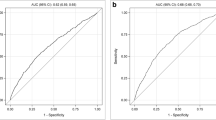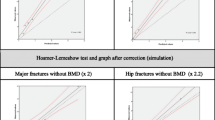Abstract
Calibration of the Finnish FRAX model was evaluated using a locally derived population-based cohort of postmenopausal women (n = 13,917). Hip fractures were observed from national register-based data and verified from radiological records. For a subpopulation of 11,182 women, there were enough data to calculate the fracture probabilities using the Finnish FRAX tool (without bone mineral density). A 10-year period prevalence of hip fractures to this subpopulation was 0.66 %. The expected numbers of hip fractures were significantly higher than the self reported ones (O/E ratio 0.46; 95 % CI 0.33–0.63), had a tendency to be greater than the observed ones (O/E ratio 0.83; 95 % CI 0.65–1.04), and calibration in terms of goodness-of-fit of absolute probabilities was questionable (P = 0.015). Strikingly, the 10-year period prevalence of hip fractures to the whole cohort was higher (0.84 %) than for the women with FRAX measurements (0.66 %). This was mainly the result of difference between people who had and who had not responded to postal enquiries (0.71 vs. 1.77 %, P < 0.0001). Self-reports missed to capture 38 % of all hip fractures in those who responded and about 45 % of hip fractures in women who had a FRAX estimate. The Finnish FRAX tool seems to provide appropriate discrimination for hip fracture risk, but caution is required in the interpretation of absolute risk, especially if used for population that may not be representing general population per se. Our study also showed that patients with no response had significantly higher hip fracture risk and that the use of purely self-reported hip fractures in calculations results in biased incidence and period prevalence estimates. Such important biases may remain unnoticed if there are no data from other sources available.
Similar content being viewed by others
References
Kanis JA, Melton LJ, Christiansen C, Johnston CC, Khaltaev N (1994) The diagnosis of osteoporosis. J Bone Miner Res 9:1137–1141
Kanis JA, Gluer CC (2000) An update on the diagnosis and assessment of osteoporosis with densitometry. Osteoporos Int 11:192–202
World Health Organization (1994) Assessment of fracture risk and its application to screening for postmenopausal osteoporosis. Technical Report Series 843. World Health Organization, Geneva
Kanis JA, Delmas P, Burckhardt P, Cooper C, Torgerson D, European Foundation for Osteoporosis and Bone Disease (1997) Guidelines for diagnosis and management of osteoporosis. Osteoporos Int 7:390–406
National Osteoporosis Foundation (NOF) (2003) Physician’s guide to prevention and treatment of osteoporosis. National Osteoporosis Foundation, Washington, DC
Kanis JA, Johnell O, Odén A, Johansson H, McCloskey EV (2008) FRAX™ and the assessment of fracture probability in men and women from the UK. Osteoporos Int 19:385–397
Kanis JA, Johnell O, De Laet C, Jonnson B, Odén A, Ogelsby AK (2002) International variations in hip fracture probability: implications for risk assessment. J Bone Miner Res 17:1237–1244
Kanis JA, Odén A, McCloskey EV, Johansson H, Wahl DA, Cooper C, IOF Working Group on Epidemiology and Quality of Life (2012) A systematic review of hip fracture incidence and probability of fracture worldwide. Osteoporos Int 23:2239–2256
Honkanen R, Kröger H, Tuppurainen M, Alhava E, Saarikoski S (1995) Fractures and low axial bone density in perimenopausal women. J Clin Epidemiol 48:881–888
Honkanen R, Tuppurainen M, Kröger H, Alhava E, Saarikoski S (1998) Relationship between risk factors and fracture differ by type of fracture: a population-based study of 12,191 perimenopausal women. Osteoporos Int 8:25–31
Sund R (2007) Utilization of routinely collected administrative data in monitoring of aging-dependent hip fracture incidence. Epidemiol Perspect Innov 4:2
Hand DJ (2010) Evaluating diagnostic tests: the area under the ROC curve and the balance of errors. Stat Med 29:1502–1510
Kanis JA, Oden A, Johnell O, Johansson H, De Laet C, Brown J, Burckhardt P, Cooper C, Christiansen C, Cummings S, Eisman JA, Fujiwara S, Glüer C, Goltzman D, Hans D, Krieg MA, La Croix A, McCloskey E, Mellstrom D, Melton LJ 3rd, Pols H, Reeve J, Sanders K, Schott AM, Silman A, Torgerson D, van Staa T, Watts NB, Yoshimura N (2007) The use of clinical risk factors enhances the performance of BMD in the prediction of hip and osteoporotic fractures in men and women. Osteoporos Int 18:1033–1046
Sund R (2006) Hip fracture incidence in Finland, 1998–2002. Duodecim 122(9):1085–1091
Honkanen K, Honkanen R, Heikkinen L, Kröger H, Saarikoski S (1999) Validity of self-reports of fractures in perimenopausal women. Am J Epidemiol 150:511–516
Sund R (2012) Quality of the Finnish Hospital Discharge Register: a systematic review. Scand J Public Health 40:505–515
Sund R, Nurmi-Lüthje I, Lüthje P, Tanninen S, Narinen A, Keskimäki I (2007) Comparing properties of audit data and routinely collected register data in case of performance assessment of hip fracture treatment in Finland. Methods Inf Med 46:558–566
Schousboe JT, Paudel ML, Taylor BC, Virnig BA, Cauley JA, Curtis JR, Ensrud KE (2013) Magnitude and consequences of misclassification of incident hip fractures in large cohort studies: the Study of Osteoporotic Fractures and Medicare claims data. Osteoporos Int 24:801–810
Nurmi-Lüthje I, Sund R, Juntunen M, Lüthje P (2011) Post-hip fracture use of prescribed calcium plus vitamin D or vitamin D supplements and anti-osteoporotic drugs are associated with lower mortality. A nationwide study in Finland. J Bone Miner Res 26:1845–1853
Kanis JA, Hans D, Cooper C, Baim S, Bilezikian JP, Binkley N, Cauley JA, Compston JE, Dawson-Hughes B, El-Hajj Fuleihan G, Johansson H, Leslie WD, Lewiecki EM, Luckey M, Oden A, Papapoulos SE, Poiana C, Rizzoli R, Wahl DA, McCloskey EV (2011) Interpretation and use of FRAX in clinical practice. Osteoporos Int 22:395–411
Kanis JA, Odén A, Johansson H, McCloskey E (2012) Pitfalls in the external validation of FRAX. Osteoporos Int 23:423–431
Honkanen R, Sund R, Tuppurainen M, Koivumaa-Honkanen H, Kröger H (2012) 20-year mortality of non-respondents in a population-based cohort (OSTPRE) study. Poster presented at: ASBMR annual meeting, Minneapolis, MN
Kanis JA, Johansson H, Odén A, Dawson-Hughes B, Melton LJ 3rd, McCloskey EV (2010) The effects of a FRAX((R)) revision for the USA. Osteoporos Int 21:35–40
Binkley N, Kiebzak GM, Lewiecki EM, Krueger D, Gangnon RE, Miller PD, Shepherd JA, Drezner MK (2005) Recalculation of the NHANES Database SD improves T-score agreement and reduces osteoporosis prevalence. J Bone Miner Res 20:195–201
Acknowledgment
Liisa Ollikainen (Lic.Sc., RN) had a significant role in obtaining the radiology reports for potential hip fractures identified in the register.
Conflict of interest
Reijo Sund, Risto Honkanen, Helena Johansson, Anders Odén and Heikki Kröger declare that they have no conflict of interest. Eugene McCloskey received speaker fees and/or unrestricted research grants from Novartis, Amgen, AstraZeneca, Pfizer, Bayer, Warner-Chilcott/Procter & Gamble, Lilly, Roche, Servier, Hologic, and GSK. John Kanis received grants from Industry: Amgen, USA, Switzerland and Belgium; D3A, France; Gador, Argentina; General Electric, USA; GSK, UK, USA; Hologic, Belgium and USA; Kissei, Japan; Lilly, USA, Canada, Japan, Australia, and UK; Merck Research Labs, USA; Merlin Ventures, UK; Novartis, Switzerland and USA; Novo Nordisk, Denmark; Nycomed, Norway; Ono, UK and Japan; Pfizer USA; Pharmexa, Denmark; ProStrakan, UK; Roche, Germany, Australia, Switzerland, and USA; Rotta Research, Italy; Sanofi-Aventis, USA; Servier, France and UK; Shire, UK; Solvay, France and Germany; Tethys, USA; Teijan, Japan; Teva, Israel; UBS, Belgium; Unigene, USA; Warburg-Pincus, UK; and from governmental and nongovernment organizations: National Institute for Health and Clinical Excellence (NICE), UK; International Osteoporosis Foundation; National Osteoporosis Guideline Group (NOGG), UK; INSERM, France; Ministry of Public Health, China; Ministry of Health, Australia; National Osteoporosis Society, UK; and World Health Organization.
Human and Animal Rights and Informed Consent
The study was approved by the Ethics Committee of the University Hospital of Kuopio, and all participants gave informed consent. Permissions to use register-based data were separately obtained from the register authorities as required in the Finnish legislation.
Author information
Authors and Affiliations
Corresponding author
Rights and permissions
About this article
Cite this article
Sund, R., Honkanen, R., Johansson, H. et al. Evaluation of the FRAX Model for Hip Fracture Predictions in the Population-based Kuopio Osteoporosis Risk Factor and Prevention Study (OSTPRE). Calcif Tissue Int 95, 39–45 (2014). https://doi.org/10.1007/s00223-014-9860-9
Received:
Accepted:
Published:
Issue Date:
DOI: https://doi.org/10.1007/s00223-014-9860-9




